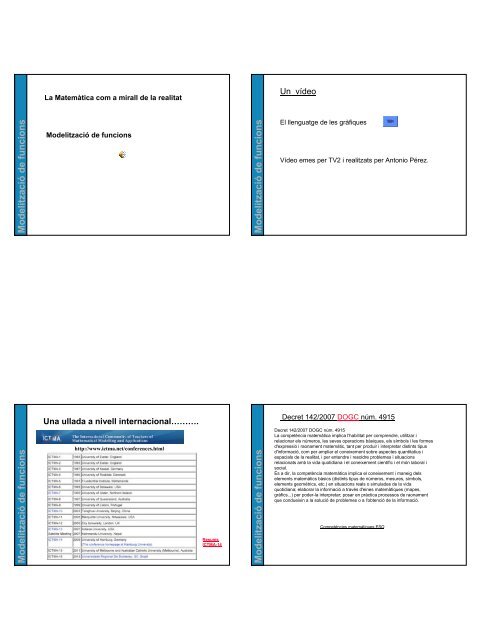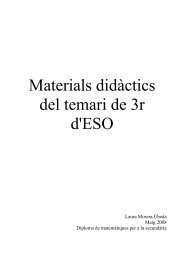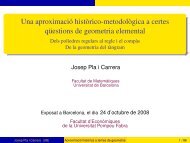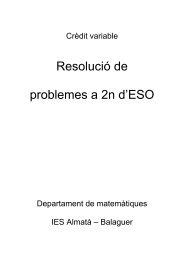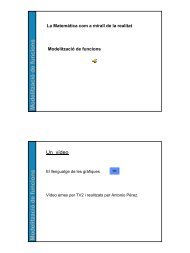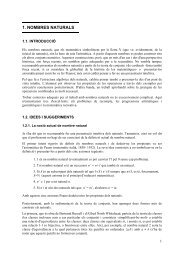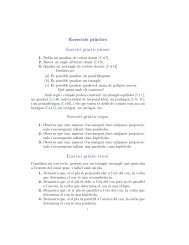Presentació - Diploma de matemàtiques per a la Secundària
Presentació - Diploma de matemàtiques per a la Secundària
Presentació - Diploma de matemàtiques per a la Secundària
Create successful ePaper yourself
Turn your PDF publications into a flip-book with our unique Google optimized e-Paper software.
Mo<strong>de</strong>lització <strong>de</strong> funcions<br />
Mo<strong>de</strong>lització <strong>de</strong> funcions<br />
La Matemàtica com a mirall <strong>de</strong> <strong>la</strong> realitat<br />
Mo<strong>de</strong>lització <strong>de</strong> funcions<br />
Una ul<strong>la</strong>da a nivell internacional……….<br />
http://www.ictma.net/conferences.html<br />
Resums<br />
ICTMA-14<br />
Mo<strong>de</strong>lització <strong>de</strong> funcions<br />
Mo<strong>de</strong>lització <strong>de</strong> funcions<br />
Un ví<strong>de</strong>o<br />
El llenguatge <strong>de</strong> les gràfiques<br />
Ví<strong>de</strong>o emes <strong>per</strong> TV2 i realitzats <strong>per</strong> Antonio Pérez.<br />
Decret 142/2007 DOGC núm. 4915<br />
Decret 142/2007 DOGC núm. 4915<br />
La competència matemàtica implica l'habilitat <strong>per</strong> comprendre, utilitzar i<br />
re<strong>la</strong>cionar els números, les seves o<strong>per</strong>acions bàsiques, els símbols i les formes<br />
d'expressió i raonament matemàtic, tant <strong>per</strong> produir i interpretar distints tipus<br />
d'informació, com <strong>per</strong> ampliar el coneixement sobre aspectes quantitatius i<br />
espacials <strong>de</strong> <strong>la</strong> realitat, i <strong>per</strong> entendre i resoldre problemes i situacions<br />
re<strong>la</strong>cionats amb <strong>la</strong> vida quotidiana i el coneixement científic i el món <strong>la</strong>boral i<br />
social.<br />
És a dir, <strong>la</strong> competència matemàtica implica el coneixement i maneig <strong>de</strong>ls<br />
elements matemàtics bàsics (distints tipus <strong>de</strong> números, mesures, símbols,<br />
elements geomètrics, etc.) en situacions reals o simu<strong>la</strong><strong>de</strong>s <strong>de</strong> <strong>la</strong> vida<br />
quotidiana; e<strong>la</strong>borar <strong>la</strong> informació a través d'eines <strong>matemàtiques</strong> (mapes,<br />
gràfics...) <strong>per</strong> po<strong>de</strong>r-<strong>la</strong> interpretar; posar en pràctica processos <strong>de</strong> raonament<br />
que condueixin a <strong>la</strong> solució <strong>de</strong> problemes o a l'obtenció <strong>de</strong> <strong>la</strong> informació.<br />
Competéncies <strong>matemàtiques</strong> ESO
Mo<strong>de</strong>lització <strong>de</strong> funcions<br />
Mo<strong>de</strong>lització <strong>de</strong> funcions<br />
Algunes referències<br />
www.upc.edu/epsevg/mo<strong>de</strong>litzacio<br />
Mo<strong>de</strong>lització <strong>de</strong> funcions<br />
Mo<strong>de</strong>lització <strong>de</strong> funcions<br />
http://msel.impa.upv.es/<br />
Des <strong>de</strong> dissenyadors <strong>de</strong> currículums, associacions <strong>de</strong> professors, etc. té especial<br />
interés en l’ensenyament activitats <strong>de</strong> mo<strong>de</strong>lització, apunto diferents referents<br />
socials que coinci<strong>de</strong>ixen a <strong>de</strong>stacar <strong>la</strong> importància d’ensenyar les <strong>matemàtiques</strong><br />
aplica<strong>de</strong>s a <strong>la</strong> vida real i fer veure les re<strong>la</strong>cions entre les <strong>matemàtiques</strong> i <strong>la</strong> realitat<br />
(epistemología); els estudis més rellevants son: l’Informe Cockroft (1982),<br />
programa PISA (OCDE, 2003), els Principios y Estándares para <strong>la</strong> Educación<br />
Matemática (SAEM Thales 2003).<br />
A més a més els currículums <strong>de</strong> <strong>matemàtiques</strong>, que alguns països<br />
proposen <strong>de</strong>s <strong>de</strong>ls anys 80 en diferents àmbits educatius, inclouen <strong>la</strong> resolució <strong>de</strong><br />
problemes, aplicacions i mo<strong>de</strong>litzacions. Aquests països, principalment, són: el<br />
Regne Unit, Austràlia, Finlàndia, Dinamarca i Ho<strong>la</strong>nda. Les raons <strong>per</strong> a aquesta<br />
inclusió estan ben expressa<strong>de</strong>s a Blum i Niss (1991) i Burkhardt (2006).<br />
En el cas <strong>de</strong> Catalunya, en el nou currículum aprovat el 26 <strong>de</strong> juny <strong>de</strong> 2007,<br />
s’estableix que a final <strong>de</strong>ls tres primers cursos es farà un treball <strong>de</strong> síntesi que ha<br />
<strong>de</strong> servir <strong>per</strong>què els alumnes mostrin com saben re<strong>la</strong>cionar els aprenentatges fets<br />
amb <strong>la</strong> vida pràctica. A <strong>la</strong> introducció <strong>de</strong> l’àrea <strong>de</strong> <strong>matemàtiques</strong> es diu que s’han<br />
<strong>de</strong> potenciar les capacitats <strong>de</strong> l’alumne <strong>per</strong> «mo<strong>de</strong>litzar situacions <strong>de</strong> <strong>la</strong> vida<br />
real»<br />
(DOGC 4915, pàg. 21873 i 21927).
Mo<strong>de</strong>lització <strong>de</strong> funcions<br />
Mo<strong>de</strong>lització <strong>de</strong> funcions<br />
Per anar fent boca!!!!<br />
Els angles d’un triangle sumen 180º? suma angles<br />
triangle.doc<br />
Un exemple <strong>de</strong> l’equació <strong>de</strong> segon grauExemple senzill <strong>de</strong>l<br />
procés <strong>de</strong> mo<strong>de</strong>lització.equacio segon grau.doc<br />
Mo<strong>de</strong>l sistema lineal 1mo<strong>de</strong>l sistema lineal 1.doc<br />
Mo<strong>de</strong>l sistema lineal 2mo<strong>de</strong>l sistema lineal 2.doc<br />
El secretEl secret.doc<br />
Trebal<strong>la</strong>r mo<strong>de</strong>ls: Oferir el mo<strong>de</strong>l fet <strong>per</strong> enriquir<br />
l’aprenentatge i mostrar aspectes epistemológics i <strong>la</strong><br />
visualització <strong>de</strong> situacions. Per exemple en<br />
criptografia, càmeres <strong>de</strong> seguretat, tractament<br />
d’imatges,…<br />
Propiciar <strong>la</strong> resolució <strong>de</strong> problemes, <strong>la</strong>boratori <strong>de</strong><br />
<strong>matemàtiques</strong>, implementar tallers, …..<br />
Roda atracció <strong>de</strong> fira<br />
Mo<strong>de</strong>lització <strong>de</strong> funcions<br />
Mo<strong>de</strong>lització <strong>de</strong> funcions<br />
Alguns problemes <strong>de</strong> mo<strong>de</strong>lització <strong>de</strong> funcions<br />
1. Roda atracció <strong>de</strong> fira<br />
2. Mes mo<strong>de</strong>ls exponencials<br />
3. Catàstrofe ecológica<br />
4. Optimitzar <strong>la</strong> longitud d’un terreny<br />
5. El bulevard<br />
6. Les crispetes<br />
7. El mon <strong>de</strong>ls envasos cilíndrics<br />
“La Matemática.Reflejo <strong>de</strong> <strong>la</strong> realidad” (Joan Gómez,<br />
2007,FESPM)<br />
Problema<br />
Suposem una atracció <strong>de</strong> fira <strong>de</strong> l’estil que mostra <strong>la</strong><br />
figura, l’anomenada roda o sínia (en castellà nória):<br />
Suposarem diverses da<strong>de</strong>s:<br />
12 cadires igualment espaia<strong>de</strong>s al l<strong>la</strong>rg <strong>de</strong>l seu<br />
<strong>per</strong>ímetre, un radi <strong>de</strong> 10 metres i a una distància <strong>de</strong>l<br />
punt més baix <strong>de</strong>l terra <strong>de</strong> 0.5 metres; també<br />
suposarem que triga 30 segons en fer una volta<br />
completa i que <strong>la</strong> seva velocitat és constant.<br />
La i<strong>de</strong>a és construir un mo<strong>de</strong>l que <strong>per</strong>meti analitzar <strong>la</strong><br />
següent qüestió:<br />
Com varia <strong>la</strong> distància , respecte el terra, d’un<br />
passatger durant el passeig?
Mo<strong>de</strong>lització <strong>de</strong> funcions<br />
Mo<strong>de</strong>lització <strong>de</strong> funcions<br />
Prenem com a mo<strong>de</strong>l el gràfic anterior i notem que <strong>la</strong> cadira “1” està a 0.5 metres <strong>de</strong>l terra. Per<br />
simplificar el problema suposarem que en l’instant t = 0, <strong>la</strong> posició està a <strong>la</strong> cadira “4”; és a dir: a<br />
10.5 metres <strong>de</strong>l terra.<br />
Notem que si en 30 segons recorre una volta sencera ( 2 π radians), aleshores en un temps <strong>de</strong> t<br />
segons recorrerà α radians, és a dir:<br />
30 t<br />
π<br />
= d’aquesta senzil<strong>la</strong> reg<strong>la</strong> <strong>de</strong> tres s’obté que α = t ; <strong>per</strong> tant en un segon recorre:<br />
2π<br />
α<br />
15<br />
π<br />
α = radians, en dos segons 2<br />
15<br />
15<br />
π<br />
α = radians, i així successivament.<br />
Amb això po<strong>de</strong>m fer una tau<strong>la</strong> amb Excel discretitzant segon <strong>per</strong> segon tal com mostra <strong>la</strong> figura:<br />
Nº <strong>de</strong> Angle en Distància<br />
segons radians <strong>de</strong>l terra<br />
0 0 10,5<br />
1 0,20943951 12,5791169<br />
2 0,41887902 14,5673664<br />
3 0,62831853 16,3778525<br />
4 0,83775804 17,9314483<br />
5 1,04719755 19,160254<br />
6 1,25663706 20,0105652<br />
7 1,46607657 20,445219<br />
8 1,67551608 20,445219<br />
9 1,88495559 20,0105652<br />
10 2,0943951 19,160254<br />
11 2,30383461 17,9314483<br />
12 2,51327412 16,3778525<br />
13 2,72271363 14,5673664<br />
14 2,93215314 12,5791169<br />
15 3,14159265 10,5<br />
16 3,35103216 8,42088309<br />
17 3,56047167 6,43263357<br />
18 3,76991118 4,62214748<br />
19 3,97935069 3,06855175<br />
20 4,1887902 1,83974596<br />
21 4,39822972 0,98943484<br />
22 4,60766923 0,55478105<br />
23 4,81710874 0,55478105<br />
24 5,02654825 0,98943484<br />
25 5,23598776 1,83974596<br />
26 5,44542727 3,06855175<br />
27 5,65486678 4,62214748<br />
28 5,86430629 6,43263357<br />
Full <strong>de</strong> càlcul Exel<br />
Full <strong>de</strong> càlcul colors<br />
10sin( α<br />
Mo<strong>de</strong>lització <strong>de</strong> funcions<br />
Mo<strong>de</strong>lització <strong>de</strong> funcions )<br />
Consi<strong>de</strong>rem <strong>la</strong> referència formada <strong>per</strong> les cadires “1” i “7” com eix d’or<strong>de</strong>na<strong>de</strong>s i les cadires “10”<br />
i “4” com eix d’abscisses, a l’instant t=0 el passatger està a <strong>la</strong> posició “4” i al cap <strong>de</strong> α radians<br />
estarà a <strong>la</strong> posició d’or<strong>de</strong>nada 10sin( α) - <strong>per</strong> <strong>la</strong> <strong>de</strong>finició <strong>de</strong> sinus d’un angle-, es a dir.<br />
π<br />
Al cap d’un <strong>de</strong>terminat temps t <strong>la</strong> posició <strong>de</strong>l passatger <strong>de</strong> <strong>la</strong> cadira “4” estarà a d = 10sin(<br />
t ) i<br />
15<br />
<strong>per</strong> tant <strong>la</strong> distància <strong>de</strong>l passatges “4” al terra serà :<br />
π<br />
D = 10.<br />
5+<br />
10sin(<br />
t ) metres.<br />
15<br />
Si representem <strong>la</strong> gràfica D= 10.5+ 10 sin(PI*x/15), tenim:<br />
plot0 10.5 C 10$ sin0 p$ x<br />
151 , x = 0 ..1801 ;<br />
plot0 10.5 C 10$ sin0 p$ x<br />
151 , x = 0 ..301
X<br />
Y = ab<br />
Mo<strong>de</strong>lització <strong>de</strong> funcions<br />
Mo<strong>de</strong>lització <strong>de</strong> funcions<br />
MODELS EXPONENCIALS<br />
Solució:<br />
Y =<br />
0.1mm = 0.0001m<br />
384.000km = 384.000.000m<br />
X<br />
ab<br />
Al doblegar un cop el full, tinc que el gruix és: 0. 0001⋅<br />
2<br />
2<br />
Al doblegar dos cops l<strong>la</strong>vors tindrem: ( 0. 0001⋅<br />
2)<br />
⋅2<br />
= 0.<br />
0001⋅<br />
2<br />
x<br />
Al doblegar x cops, el gruix <strong>de</strong>l pa<strong>per</strong> és: 0. 0001⋅<br />
2<br />
El mo<strong>de</strong>l serà l’equació exponencial :<br />
x<br />
0 . 0001⋅<br />
2 = 384.<br />
000.<br />
000<br />
Per tant, <strong>per</strong> a calcu<strong>la</strong>r el número <strong>de</strong> cops que haurem <strong>de</strong> doblegar el full <strong>per</strong> calcu<strong>la</strong>r <strong>la</strong> distància <strong>de</strong><br />
<strong>la</strong> Terra a <strong>la</strong> Lluna , resoldrem aquesta equació exponencial.<br />
x<br />
x<br />
12<br />
0.<br />
0001⋅<br />
2 = 384.<br />
000.<br />
000 ⇒ 2 = 3.<br />
84⋅10<br />
⇒ x = 41.<br />
80424⇒<br />
x = 42<br />
Per tant, calen 42 doblecs <strong>de</strong>l full<br />
Mo<strong>de</strong>lització <strong>de</strong> funcions<br />
Mo<strong>de</strong>lització <strong>de</strong> funcions<br />
Els doblecs d’un full <strong>de</strong> pa<strong>per</strong><br />
• Quantes vega<strong>de</strong>s tenim que doblegar un full <strong>de</strong> pa<strong>per</strong> <strong>per</strong> tal que, a l’augmentar el seu<br />
gruix, tinguem <strong>la</strong> distància <strong>de</strong> <strong>la</strong> Terra a <strong>la</strong> Lluna?<br />
Notes: gruix d’un full <strong>de</strong> pa<strong>per</strong> = 0.1mm<br />
Distància Terra – Lluna = 384.000km<br />
Ma<strong>la</strong>lties<br />
Exemple1: En una enfermetat hi han tres <strong>per</strong>sones contagia<strong>de</strong>s inicialment. Cadascun<br />
d’aquests contagia a una altra <strong>per</strong>sona cada setmana.<br />
a) Calcu<strong>la</strong>r el nombre <strong>de</strong> <strong>per</strong>sones ma<strong>la</strong>ltes al cap <strong>de</strong> 1, 2, ..., x setmanes.<br />
b) Quant <strong>de</strong> temps ha passar <strong>per</strong> què hi hagin 6.144 <strong>per</strong>sones amb <strong>la</strong> ma<strong>la</strong>ltia?
Mo<strong>de</strong>lització <strong>de</strong> funcions<br />
Mo<strong>de</strong>lització <strong>de</strong> funcions<br />
a) Calcu<strong>la</strong>r el nombre <strong>de</strong> <strong>per</strong>sones ma<strong>la</strong>ltes al cap <strong>de</strong> 1, 2, ..., x setmanes.<br />
Inicialment (setmana 0) hi ha tres <strong>per</strong>sones contagia<strong>de</strong>s: P1, P2, P3.<br />
L<strong>la</strong>vors, tindrem que:<br />
SETMANA 0 SETMANA 1 SETMANA 2<br />
P1 contagia 1 contagia 1<br />
contagia 1<br />
P2 contagia 1 contagia 1<br />
contagia 1<br />
P3 contagia 1 contagia 1<br />
contagia 1<br />
Ma<strong>la</strong>lts: 3 6 12<br />
Setmana 0 Set. 0 + Set. 1 Set. 0 + Set. 1 + Set. 2<br />
0<br />
3 = 3⋅<br />
2<br />
1<br />
6 = 3⋅<br />
2<br />
2<br />
12 = 3⋅<br />
2<br />
Aquestes consi<strong>de</strong>racions anteriors, aplicant-les <strong>per</strong> a <strong>la</strong> setmana x serà: 32 x<br />
⋅ . Per tant, el nombre <strong>de</strong><br />
ma<strong>la</strong>lts en x setmanes si el <strong>de</strong>signem <strong>per</strong> y tindrem que el mo<strong>de</strong>l és <strong>la</strong> funció exponencial:<br />
Exemple2:<br />
x<br />
y = 3⋅ 2<br />
Consi<strong>de</strong>rem en una enfermetat que cada <strong>per</strong>sona contagia a unes altres 3 <strong>per</strong>sones al cap <strong>de</strong> 2<br />
setmanes, <strong>per</strong>ò no torna a contagiar més l’enfermetat. Inicialment hi havien 7 <strong>per</strong>sones<br />
contagia<strong>de</strong>s.<br />
a) Calcu<strong>la</strong>r el nombre <strong>de</strong> <strong>per</strong>sones que s’han contagiat a <strong>la</strong> 8a setmana.<br />
b) Calcu<strong>la</strong>r el número total <strong>de</strong> <strong>per</strong>sones contagia<strong>de</strong>s en aquestes 8 setmanes.<br />
c) Quin és el número <strong>de</strong> <strong>per</strong>sones que es van contagiar a <strong>la</strong> setmana x? I el<br />
nombre <strong>de</strong> <strong>per</strong>sones total en aquestes x setmanes?<br />
d) Quantes setmanes han <strong>de</strong> passar <strong>per</strong> tal que <strong>la</strong> darrera setmana hi hagin<br />
137.781 ma<strong>la</strong>lts?<br />
e) Quin número <strong>de</strong> setmanes han <strong>de</strong> passar fins que es trobin un total <strong>de</strong> 22.960<br />
<strong>per</strong>sones ma<strong>la</strong>ltes?<br />
Mo<strong>de</strong>lització <strong>de</strong> funcions<br />
Mo<strong>de</strong>lització <strong>de</strong> funcions<br />
b) Quant <strong>de</strong> temps ha passar <strong>per</strong> què hi hagin 6.144 <strong>per</strong>sones amb <strong>la</strong><br />
ma<strong>la</strong>ltia?<br />
Hem <strong>de</strong> resoldre:<br />
x<br />
x 6144<br />
x 11<br />
3⋅<br />
2 = 6144⇒<br />
2 = = 2048⇒<br />
2 = 2 ⇒ x = 11<br />
3<br />
Per tant, al cap d’11 setmanes hi hauran 6144 contagiats.<br />
a) Calcu<strong>la</strong>r el nombre <strong>de</strong> <strong>per</strong>sones que s’han s han contagiat a <strong>la</strong> 8a<br />
setmana.<br />
És a dir, que al cap <strong>de</strong> 2 setmanes hi haurà:<br />
7 ⋅ 3 = 21<br />
2 setmanes següents, el nombre <strong>de</strong> ma<strong>la</strong>lts serà <strong>de</strong>:<br />
2<br />
( 7 ⋅ 3)<br />
⋅3<br />
= 7⋅<br />
3<br />
Fent les mateixes o<strong>per</strong>acions, calcu<strong>la</strong>rem el nombre <strong>de</strong> ma<strong>la</strong>lts que seran a<br />
<strong>la</strong> 8a setmana:<br />
3 ( 7 ⋅3) ⋅3<br />
= 567 ma<strong>la</strong>lts
Mo<strong>de</strong>lització <strong>de</strong> funcions<br />
Mo<strong>de</strong>lització <strong>de</strong> funcions<br />
b) Calcu<strong>la</strong>r el número total <strong>de</strong> <strong>per</strong>sones contagia<strong>de</strong>s en aquestes 8<br />
setmanes.<br />
Es pot dir que, en general, l’o<strong>per</strong>ació a seguir és:<br />
2a set. 4a set. 6a set. 8a set. x set.<br />
1<br />
7 ⋅ 3<br />
2<br />
7 ⋅ 3<br />
3<br />
7 ⋅ 3<br />
O<strong>per</strong>ant, calculem el nombre total <strong>de</strong> ma<strong>la</strong>lts en 8 setmanes:<br />
1 2 3 4<br />
7 ⋅3 + 7 ⋅3<br />
+ 7 ⋅3<br />
+ 7 ⋅3<br />
= 847 ma<strong>la</strong>lts<br />
x<br />
4<br />
2<br />
7 ⋅ 3 7 ⋅ 3<br />
d) Quantes setmanes han <strong>de</strong> passar <strong>per</strong> tal que <strong>la</strong> darrera setmana hi<br />
hagin 137.781 ma<strong>la</strong>lts? e) Quin número <strong>de</strong> setmanes han <strong>de</strong> passar<br />
fins que es trobin un total <strong>de</strong> 22.960 <strong>per</strong>sones ma<strong>la</strong>ltes?<br />
d)<br />
Per a saber les setmanes que han <strong>de</strong> passar, hem <strong>de</strong> resoldre:<br />
e)<br />
x<br />
x<br />
x<br />
2 137.<br />
781 2<br />
2<br />
137.<br />
781 = 7 ⋅3<br />
⇒ = 3 ⇒19.<br />
683 = 3 ⇒<br />
7<br />
x<br />
2<br />
9 x<br />
⇒ 3 = 3 ⇒ = 9 ⇒ x = 18<br />
2<br />
Si volem saber el número <strong>de</strong> setmanes que han <strong>de</strong> passar fins que es trobin un total <strong>de</strong> 22.960<br />
<strong>per</strong>sones ma<strong>la</strong>ltes l’expressió:<br />
( x<br />
2 ) + 1<br />
( x<br />
( x ) + 1<br />
7 ⋅3<br />
− 7<br />
2 ) + 1<br />
2<br />
8<br />
x<br />
22.<br />
960 =<br />
⇒ 6561 = 3 ⇒ 3 = 3 ⇒ 8 = + 1⇒<br />
x = 14 ,<br />
2<br />
2<br />
Per tant, hauran <strong>de</strong> passar 14 setmanes<br />
Document sencer<br />
Mo<strong>de</strong>lització <strong>de</strong> funcions<br />
Mo<strong>de</strong>lització <strong>de</strong> funcions<br />
c)Quin és el número <strong>de</strong> <strong>per</strong>sones que es van contagiar a <strong>la</strong> setmana x? I el nombre<br />
<strong>de</strong> <strong>per</strong>sones total en aquestes x setmanes?<br />
2<br />
A <strong>la</strong> setmana x es contagien 7 3<br />
x<br />
⋅ ma<strong>la</strong>lts.<br />
Per a calcu<strong>la</strong>r el número total <strong>de</strong> <strong>per</strong>sones ma<strong>la</strong>ltes en x setmanes haurem <strong>de</strong> recórrer a <strong>la</strong> fórmu<strong>la</strong><br />
<strong>de</strong> <strong>la</strong> progressió geomètrica multiplicada <strong>per</strong> un terme z in<strong>de</strong>pen<strong>de</strong>nt:<br />
n<br />
a1<br />
⋅<br />
(<br />
) ( r −1)<br />
Sn<br />
= a1<br />
+ a2<br />
+ ... + an<br />
=<br />
r −1<br />
Aplicant aquesta fórmu<strong>la</strong>, tindrem que:<br />
0<br />
7⋅<br />
3 + 7<br />
1 2<br />
x 2 0 1 2<br />
x 2<br />
⋅3<br />
+ 7⋅<br />
3 + ... + 7⋅<br />
3 = 7⋅<br />
( 3 + 3 + 3 + ... + 3 )<br />
( x 2)<br />
+ 1<br />
⋅(<br />
3 −1)<br />
( x 2)<br />
+ 1<br />
7⋅<br />
( 3 −1)<br />
( x 2)<br />
+ 1<br />
7⋅<br />
3 − 7<br />
0<br />
3<br />
⇒ 7⋅<br />
3−<br />
1<br />
=<br />
2<br />
=<br />
2<br />
= 7⋅<br />
Sn<br />
⇒<br />
aplicant <strong>la</strong> fórmu<strong>la</strong><br />
Tenim doncs, que el mo<strong>de</strong>l és <strong>la</strong> suma d’una progressió geomètrica,, el nombre total “S” <strong>de</strong><br />
<strong>per</strong>sones contagia<strong>de</strong>s en “x” setmanes vindrà donat <strong>per</strong> l’expressió:<br />
( x 2)<br />
+ 1<br />
7 ⋅ 3 − 7<br />
S =<br />
2<br />
Contínuament llegim als diaris sobre vaixells que tenen<br />
acci<strong>de</strong>nts en el mar i provoquen <strong>la</strong> mort <strong>de</strong> milers <strong>de</strong><br />
peixos, aus i altres espècies d’animals. Una noticia com<br />
<strong>la</strong> següent feia sorgir un dubte, serà gaire car netejar el<br />
mar <strong>de</strong>ls contaminants que s′han abocat?.<br />
⇒
Mo<strong>de</strong>lització <strong>de</strong> funcions<br />
Mo<strong>de</strong>lització <strong>de</strong> funcions<br />
Un vaixell que transportava 3 000 m3 <strong>de</strong> petroli, producte<br />
altament contaminant, s’enfonsa originant una taca <strong>de</strong> forma<br />
circu<strong>la</strong>r, amb el punt <strong>de</strong> l’enfonsament com a centre. Aquesta<br />
taca s’estén mantenint aquesta forma geométrica i amb un<br />
espesor uniforme en tota <strong>la</strong> su<strong>per</strong>fície, el valor <strong>de</strong> <strong>la</strong> qual en<br />
metres, t hores <strong>de</strong>sprés <strong>de</strong> l’enfonsament, ve donada <strong>per</strong> <strong>la</strong><br />
funció h (t) :<br />
h (t) = [ α.2 -(t/β) ] 2 (1)<br />
Greenpeace acu<strong>de</strong>ix al lloc <strong>de</strong> l’acci<strong>de</strong>nt i aconsegueix, 15<br />
hores <strong>de</strong>sprés <strong>de</strong> l’enfonsament, acordonar <strong>la</strong> taca pel seu<br />
<strong>per</strong>ímetre amb una barrera d’un producte que anu<strong>la</strong> <strong>la</strong> seva<br />
propagació i l’elimina progressivament.<br />
Supposant que és necessari utilitzar 0,5 m3/m ( m3 <strong>per</strong><br />
metre <strong>de</strong> longitud <strong>de</strong>l <strong>per</strong>ímetre <strong>de</strong> <strong>la</strong> taca) d’aquest<br />
producte i que el preu <strong>de</strong>l mateix és 10 000 euros/m3 i que<br />
tot el petroli <strong>de</strong>l vaixell ha anat a parar al mar.<br />
Tenint en conte que: α = √ 2 I β = 5 hores<br />
Quant costarà, econòmicament, netejar <strong>la</strong> taca <strong>de</strong> petroli?.<br />
Seguidament i d'acord amb l'enunciat, <strong>la</strong> taca té, a cada instant t, <strong>la</strong> forma d'un cilindre <strong>de</strong> radi R(t) i alçada h(t) com es<br />
pot veure a <strong>la</strong> figura 1 i que representa el mo<strong>de</strong>l gràfic <strong>de</strong> <strong>la</strong> situació.<br />
A mesura que<br />
transcorre el<br />
temps i <strong>la</strong> taca<br />
s'estén,<br />
disminueix el seu<br />
gruix i augmenta<br />
el seu radi, <strong>per</strong>ò<br />
sempre conté el<br />
mateix volum V <strong>de</strong> petroli.<br />
Per tant, a cada instant t s'ha <strong>de</strong> verificar que:<br />
fig 1<br />
V = π R ( t) ht ( ) ( 2)<br />
2<br />
Mo<strong>de</strong>lització <strong>de</strong> funcions<br />
Mo<strong>de</strong>lització <strong>de</strong> funcions<br />
Da<strong>de</strong>s:<br />
V = 3 000 m3.<br />
α = √ 2 m.<br />
β = 5 hores.<br />
γ = 0,5 m3/m.<br />
P = 10 000 euros/m3.<br />
t∗ = 15 hores.<br />
Mo<strong>de</strong>l gràfic i p<strong>la</strong>ntejament :<br />
Les crispetes<br />
Encara existeixen moltes sales <strong>de</strong> cinema on es <strong>per</strong>met (<br />
incentivat en molts casos ) menjar bombons, xoco<strong>la</strong>tes, ... i<br />
crispetes ! Les pa<strong>per</strong>ines que el venedors utilitzen <strong>per</strong> contenir<br />
les crispetes són generalment <strong>de</strong> pa<strong>per</strong>, <strong>per</strong>ò els formats solen<br />
variar bastant.<br />
Una <strong>de</strong>terminada fàbrica <strong>de</strong> pa<strong>per</strong>ines opta <strong>per</strong> fabricar-les a<br />
partir d'un cercle <strong>de</strong> pa<strong>per</strong> amb un <strong>de</strong>terminat radi R, tal<strong>la</strong>nt una<br />
secció corresponent a un cert angle α i amb <strong>la</strong> secció sobrant<br />
fabrica un con unit <strong>per</strong> les dues extremitats retal<strong>la</strong><strong>de</strong>s. Tal com<br />
mostra <strong>la</strong> figura següent:<br />
α<br />
Quin és l'angle α que <strong>per</strong>met construir <strong>la</strong> pa<strong>per</strong>ina on hi càpiga el major<br />
volum <strong>de</strong> crispetes?
X<br />
Y = ab<br />
Mo<strong>de</strong>lització <strong>de</strong> funcions<br />
Mo<strong>de</strong>lització <strong>de</strong> funcions<br />
Optimitzar <strong>la</strong> longitud d’un<br />
terreny<br />
x<br />
Un poliesportiu a <strong>la</strong> vorera d’un riu<br />
CAMP x<br />
Volem que <strong>la</strong> longitud sigui mínima:<br />
Sabem que x ⋅ y = 3200<br />
L = 2 x + y<br />
y<br />
Notem que n’hi x n’hi y po<strong>de</strong>n prendre valors negatius, <strong>de</strong>l fet<br />
3200<br />
x ⋅ y = 3200 tenim que y =<br />
x<br />
Aleshores:<br />
3200<br />
L = 2 x + y = 2x<br />
+ amb x > 0 cal trobar el mínim valor <strong>de</strong> L<br />
x<br />
Mo<strong>de</strong>lització <strong>de</strong> funcions<br />
Mo<strong>de</strong>lització <strong>de</strong> funcions<br />
EL POLIESPORTIU<br />
Volem construir un camp rectangu<strong>la</strong>r <strong>de</strong> ubicat a <strong>la</strong> vorera d’un riu:<br />
CAMP<br />
No volem posar cap tanca <strong>de</strong> limitació amb el riu.<br />
Quines dimensions ha <strong>de</strong> tenir el camp <strong>per</strong> tal <strong>de</strong> que<br />
s’utilitzi el mínim <strong>de</strong> <strong>la</strong> val<strong>la</strong> possible i quina serà <strong>la</strong><br />
mesura <strong>de</strong> <strong>la</strong> val<strong>la</strong>?<br />
Raonament clàsic<br />
1<br />
Derivem L i tenim L '= 2 − 3200 ⋅ = 0 ⇒ x = ± 40 com que x ha <strong>de</strong> fer positiu, prenem el<br />
2<br />
x<br />
3200 3200<br />
valor x = 40 <strong>per</strong> tant y = = 80 i en tal cas <strong>la</strong> longitud serà L = 2 ⋅ 40 + = 160m.<br />
40<br />
40<br />
La situació lineal serà:<br />
40<br />
m<br />
CAMP 40 m<br />
80 m
Mo<strong>de</strong>lització <strong>de</strong> funcions<br />
Mo<strong>de</strong>lització <strong>de</strong> funcions<br />
Raonament <strong>per</strong> “assaig”<br />
3200<br />
Representem el gràfic L(<br />
x)<br />
= 2x<br />
+ <strong>per</strong> x > 0 i ens fixem quin<br />
x<br />
x ens proporciona <strong>la</strong> longitud mínima.<br />
x y L x·y<br />
10 320 340 3200<br />
15 213,333333 243,333333 3200<br />
20 160 200 3200<br />
25 128 178 3200<br />
30 106,666667 166,666667 3200<br />
35 91,4285714 161,428571 3200<br />
40 80 160 3200<br />
45 71,1111111 161,111111 3200<br />
50 64 164 3200<br />
55 58,1818182 168,181818 3200<br />
60 53,3333333 173,333333 3200<br />
65 49,2307692 179,230769 3200<br />
70 45,7142857 185,714286 3200<br />
Construcció d’un petit centre comercial<br />
Mo<strong>de</strong>lització <strong>de</strong> funcions<br />
Mo<strong>de</strong>lització <strong>de</strong> funcions<br />
Raonament gràfic<br />
plot(2*x+(3200/x),x=25..50);<br />
Longitud<br />
SITUACIÓ I OBJECTIU<br />
Valors <strong>de</strong> x<br />
L’objectiu d’aquest treball és construir un centre comercial <strong>per</strong> tal <strong>de</strong> calcu<strong>la</strong>r el mínim cost<br />
que suposa <strong>la</strong> seva construcció. El treball està inspirat en <strong>la</strong> construcció <strong>de</strong> les galeries<br />
comercials “Roxy” <strong>de</strong> Vi<strong>la</strong>nova i <strong>la</strong> Geltrú.<br />
Imatge <strong>de</strong> l’entrada<br />
Imatge <strong>de</strong>l passadís interior amb quatre botigues<br />
El petit centre comercial consta <strong>de</strong> vuit botigues amb un passadís central. El seu plànol es troba<br />
representat a continuació:<br />
Document<br />
sencer
Mo<strong>de</strong>lització <strong>de</strong> funcions<br />
Mo<strong>de</strong>lització <strong>de</strong> funcions<br />
Assaig<br />
x y xy CT<br />
1 150 150 61960<br />
1.5 100 150 42520<br />
2 75 150 33080<br />
2.5 60 150 27640<br />
3 50 150 24200<br />
3.5 42.85 150 21902.85<br />
4 37.5 150 20320<br />
4.5 33.3 150 19213.3<br />
5 30 150 18440<br />
5.5 27.27 150 17909.09<br />
6 25 150 17560<br />
6.5 23.07 150 17350.76<br />
7 21.42 150 17251.42<br />
7.5 20 150 17240<br />
8 18.75 150 17300<br />
8.5 17.64 150 17418<br />
9 16.67 150 17586.6<br />
9.5 15.79 150 17795.6<br />
10 15 150 18040<br />
10.5 14.28 150 18314<br />
11 13.63 150 18614.5<br />
El centre comercial consta <strong>de</strong> vuit botigues<br />
rectangu<strong>la</strong>rs iguals ( marca<strong>de</strong>s amb una T<br />
en el plànol ). Cada un <strong>de</strong>ls establiments té<br />
150 m2 <strong>de</strong> su<strong>per</strong>fície. El passadís central,<br />
juntament amb l’entrada principal han <strong>de</strong><br />
tenir 6 m d’ample.<br />
Cal dir, que les línies punteja<strong>de</strong>s que<br />
apareixen en el plànol representen<br />
divisions fetes <strong>de</strong> vidre.<br />
Es vol <strong>de</strong>terminar les dimensions exteriors<br />
que ha <strong>de</strong> tenir aquest centre <strong>per</strong>què el<br />
seu cost <strong>de</strong> construcció sigui el menor<br />
possible.<br />
Com a da<strong>de</strong>s addicionals es coneix que<br />
<strong>la</strong> construcció <strong>de</strong> paret costa 40 euros el<br />
metre lineal i les divisions <strong>de</strong> vidre tenen<br />
un cost <strong>de</strong> 100 euros <strong>per</strong> metre lineal.<br />
Notem que el valor mínim està “a ull” pels valors d’x compresos entre 7 i 7.5<br />
Mo<strong>de</strong>lització <strong>de</strong> funcions<br />
Mo<strong>de</strong>lització <strong>de</strong> funcions<br />
Metres <strong>de</strong> vidre: 8x + 6<br />
L’enunciat <strong>de</strong> <strong>la</strong> situació ens diu que el cost<br />
<strong>de</strong>l vidre és <strong>de</strong> 100 euros <strong>per</strong> metre, <strong>per</strong> tant<br />
contarem l’espai <strong>de</strong>l centre que és <strong>de</strong> vidre i el<br />
multipliquem <strong>per</strong> 100. I queda:<br />
100·(8x+6) ; on el 8 representa el nombre <strong>de</strong><br />
botigues <strong>de</strong>l centre i 6 els metres<br />
corresponents a l’entrada principal.<br />
A continuació, seguint el plànol <strong>de</strong>l centre<br />
comercial, es mira l’espai <strong>de</strong> paret que hi ha i<br />
es multiplica <strong>per</strong> 40 euros. Queda una<br />
expressió <strong>de</strong>l tipus:<br />
2y+6 + 4x + 2y + 4x +6y = 10y + 8x+ 6 → 40(10y<br />
+ 8x+ 6) on:<br />
2y+6 → correspon a l’espai <strong>de</strong> <strong>la</strong> part <strong>de</strong>l<br />
darrere <strong>de</strong>l centre<br />
4x → correspon als dos <strong>la</strong>terals, en els que<br />
cada un té 4 botigues.<br />
2y → corresponent a <strong>la</strong> paret <strong>de</strong> <strong>la</strong> part <strong>de</strong>l<br />
davant<br />
I <strong>per</strong> últim, cal també tenir en compte l’espai<br />
<strong>de</strong> les divisions entre els establiments <strong>de</strong>l<br />
centre, que seria 6y.<br />
El cost total <strong>de</strong> <strong>la</strong> construcció seria doncs:<br />
C(x,y)=100 (8x + 6) + 40 (10y+8x+6) ,<br />
on x· y = 150 m2 (<strong>de</strong> su<strong>per</strong>fície <strong>de</strong> cada<br />
botiga.)<br />
Visualització gràfica<br />
Fent y = 150/x l’equació queda <strong>de</strong> <strong>la</strong> següent manera:<br />
CT = 100 (8x + 6 )+ 40 (1500 · 1/x + 8x + 6 )<br />
Plot(100 (8x + 6 )+ 40 (1500 · 1/x + 8x + 6 ),x=1.5..25);<br />
Plot(100 (8x + 6 )+ 40 (1500 · 1/x + 8x + 6 ),x=5..9);
Mo<strong>de</strong>lització <strong>de</strong> funcions<br />
Mo<strong>de</strong>lització <strong>de</strong> funcions<br />
Usant <strong>de</strong>riva<strong>de</strong>s<br />
Procedirem usant <strong>de</strong>riva<strong>de</strong>s:<br />
Teníem que CT= 100 (8x + 6 )+ 40 (1500 · 1/x + 8x + 6 );<br />
Aleshores:<br />
(CT)´ = 100 ( 8) + 40 ( 1500 ( -1/X2 ) + 8 ) = 0<br />
Si igualem a zero <strong>la</strong> <strong>de</strong>rivada trobarem el punt mínim <strong>de</strong> <strong>la</strong><br />
funció:<br />
X = 7.32 metres<br />
La “y” serà <strong>per</strong> tant:<br />
y = 150/x =150/ 7.32 = 20.5 metres<br />
Per aquests valors el cost total és: 17235.12131 euros<br />
Document sencer<br />
Es tracta <strong>de</strong> trobar les dimensions <strong>per</strong> a fabricar<br />
l<strong>la</strong>unes <strong>per</strong> emmagatzemar una quantitat d’uns 33 cl<br />
<strong>de</strong> beguda, estalviant el màxim d’alumini possible<br />
L’empresa Coca-co<strong>la</strong> te diversos tipus<br />
d’envàs,entre ells, el clàssic i el més actual <strong>de</strong><br />
forma més al<strong>la</strong>rgada.<br />
Mo<strong>de</strong>lització <strong>de</strong> funcions<br />
Mo<strong>de</strong>lització <strong>de</strong> funcions<br />
El mon <strong>de</strong>ls envasos:<br />
Optimitzar su<strong>per</strong>fícies <strong>de</strong><br />
cilindres<br />
Envás clàssic<br />
El volum és <strong>de</strong> 33cl es a dir: .Suposem que <strong>la</strong> base i <strong>la</strong> tapadora<br />
<strong>de</strong>l recipient es p<strong>la</strong>na. Suposarem també que sigui un cilindri<br />
<strong>per</strong>fecte i ignorem el ganxo <strong>per</strong> obrir <strong>la</strong> l<strong>la</strong>una. Ex<strong>per</strong>imentalment<br />
s’ha trobat que el gruix <strong>la</strong>teral <strong>de</strong> <strong>la</strong> l<strong>la</strong>una es <strong>de</strong> 0,508mm. I que <strong>la</strong><br />
quantitat d’alumini <strong>de</strong> <strong>la</strong> tapa es el triple que el <strong>de</strong> les parets tal<br />
com mostra <strong>la</strong> figura:
Mo<strong>de</strong>lització <strong>de</strong> funcions<br />
Mo<strong>de</strong>lització <strong>de</strong> funcions<br />
La quantitat d’alumini serà igual a <strong>la</strong> quantitat d’alumini en <strong>la</strong><br />
base, mes <strong>la</strong> quantitat al <strong>la</strong>teral i mes <strong>la</strong> tapa (3 vega<strong>de</strong>s <strong>la</strong> base).<br />
Es a dir, <strong>la</strong> funció a optimitzar (minimitzar) serà:<br />
2<br />
Q. Al = 4 ⋅ 0,<br />
508 ⋅π<br />
⋅ r + 2π<br />
⋅ r ⋅ h ⋅ 0,<br />
508<br />
El primer terme <strong>de</strong> l’expressió és <strong>la</strong> quantitat d’alumini que hi ha entre <strong>la</strong> base i <strong>la</strong><br />
tapa, recor<strong>de</strong>m que <strong>la</strong> tapa te tres vega<strong>de</strong>s <strong>la</strong> quantitat d’alumini <strong>de</strong> <strong>la</strong> base.<br />
El segon terme es <strong>la</strong> quantitat d’alumini que te el <strong>la</strong>teral <strong>de</strong> <strong>la</strong> l<strong>la</strong>una.<br />
2<br />
Treien factor comú, l’expressió queda: Q. Al = 0,<br />
508π<br />
⋅ ( 4 ⋅ r + 2 ⋅ r ⋅ h)<br />
2<br />
2<br />
Lligam:<br />
3<br />
2<br />
ˆ 333.<br />
333,<br />
3ˆ V = π ⋅ r ⋅ h → 333.<br />
333,<br />
= π ⋅ r ⋅ h → h =<br />
π ⋅ r<br />
Substituint a l’expressió anterior queda:<br />
⎛ ⋅ 3 1 ⎞<br />
Q Al = ⋅ ⋅⎜<br />
⋅ ⎟<br />
⎜<br />
⋅ r +<br />
⎟<br />
⎝<br />
r ⎠<br />
ˆ<br />
2 2 333.<br />
333,<br />
. 0,<br />
508 π 4<br />
π<br />
Si usem <strong>de</strong>riva<strong>de</strong>s, tenim:<br />
⎛ ⋅ 3 1 ⎞<br />
′ = ⋅ ⋅⎜<br />
⎟<br />
⎜<br />
⋅ −<br />
⋅ 2 ⎟<br />
⎝<br />
⎠<br />
ˆ 2 333.<br />
333,<br />
Q.<br />
al<br />
0,<br />
508 π 8 r<br />
π r<br />
Igua<strong>la</strong>nt a zero i aïl<strong>la</strong>nt el radi s’obté: r=2,98cm i <strong>per</strong> tant<br />
l’alçada és:<br />
3<br />
11,925cm<br />
ˆ 333.<br />
333,<br />
h = = 2<br />
π ⋅ r<br />
L’altura i el radi que ens proporciona el fabricant <strong>de</strong> l’envàs<br />
clàssic <strong>de</strong> coca-co<strong>la</strong> és:<br />
h =11,5cm i r = 2,7cm.<br />
Per tant po<strong>de</strong>m afirmar que l’empresa coca-co<strong>la</strong> ha utilitzat<br />
optimització <strong>per</strong> estalviar-se material en <strong>la</strong> construcció <strong>de</strong> les<br />
l<strong>la</strong>unes.<br />
Mo<strong>de</strong>lització <strong>de</strong> funcions<br />
Mo<strong>de</strong>lització <strong>de</strong> funcions<br />
Visualment observem que el mínim està a l’entorn <strong>de</strong>l 29.8<br />
plot(0.508*Pi*(4*r^2+(2*333333.3/Pi)*(1/r)),r=1..100);<br />
Si ens aproximem gràficament als voltants <strong>de</strong>l<br />
29,8 tenim:<br />
plot(0.508*Pi*(4*r^2+(2*333333.3/Pi)*(1/r))<br />
,r=29.4..30.5);<br />
L’envàs nou <strong>de</strong> Coca-Co<strong>la</strong><br />
Ex<strong>per</strong>imentalment es comprova que en el nou envàs <strong>de</strong> Coca-Co<strong>la</strong>, <strong>la</strong> tapa és<br />
quatre vega<strong>de</strong>s el gruix <strong>de</strong> les parets, si anomeno g al gruix <strong>de</strong> les parets tenim<br />
2<br />
que <strong>la</strong> quantitat d’alumini <strong>de</strong> <strong>la</strong> tapa és 4gπr Es tracta <strong>de</strong> trobar les dimensions <strong>de</strong>l nou envàs que minimitzen <strong>la</strong> quantitat<br />
d’alumini.<br />
Quantitat Alumini<br />
Tenim les da<strong>de</strong>s:<br />
Q = Quantitat d’alumini= Quantitat en <strong>la</strong> tapa+quantitat en <strong>la</strong> base +quantitat en les parets =<br />
2<br />
2<br />
2<br />
4π<br />
r g + πr<br />
g + 2πrhg<br />
= g ( 5πr<br />
+ 2πrh<br />
) = gπ<br />
( 5r<br />
+ 2πh<br />
)<br />
Com a lligam tenim :<br />
3<br />
2<br />
2<br />
ˆ<br />
V 333333 ,<br />
h = =<br />
πr<br />
πr<br />
Si ho substituïm a Q s’obté:<br />
6<br />
)<br />
ˆ<br />
3 666666 .<br />
) ( 5<br />
ˆ<br />
2 333333 ,<br />
2<br />
Q =<br />
gπ<br />
( 5r<br />
+ 2r<br />
= gπ<br />
r +<br />
2<br />
πr<br />
rπ
Mo<strong>de</strong>lització <strong>de</strong> funcions<br />
Mo<strong>de</strong>lització <strong>de</strong> funcions<br />
Si <strong>de</strong>rivem tenim:<br />
6<br />
)<br />
ˆ 666666 .<br />
Q`= gπ<br />
( 10r<br />
− 2<br />
r π<br />
Igua<strong>la</strong>nt a zero <strong>la</strong> primera <strong>de</strong>rivada s’obté:<br />
6<br />
0<br />
ˆ 666666 .<br />
10r − =<br />
2<br />
r π<br />
I <strong>per</strong> tant el radi queda com:<br />
6<br />
r 27.<br />
68553728 mm<br />
10<br />
ˆ 666666 ,<br />
= 3 =<br />
i <strong>per</strong> tant un diàmetre <strong>de</strong> 55,37107456 mm<br />
π<br />
I l’alçada:<br />
V<br />
3<br />
h 138 . 427864 mm<br />
r ( 27.<br />
68553728 )<br />
ˆ 333333 ,<br />
= =<br />
=<br />
2<br />
2<br />
π π<br />
Verifiquem i comparem les da<strong>de</strong>s obtingu<strong>de</strong>s amb les<br />
dimensions <strong>de</strong> l’envàs real<br />
Alçada l<strong>la</strong>una real: 143 mm= 14.3 cm<br />
Alçada l<strong>la</strong>una usant optimització: 138 mm =13.8 cm<br />
Radi l<strong>la</strong>una real: 27 mm= 2.7 cm<br />
Radi l<strong>la</strong>una usant optimització: 28 mm= 2.8 cm<br />
Conclusions<br />
Després <strong>de</strong> realitzar el càlcul d’optimització i comparar<br />
els resultats obtinguts amb els resultats reals <strong>de</strong> les<br />
dimensions <strong>de</strong>l nou envàs, po<strong>de</strong>m afirmar que <strong>la</strong> firma<br />
Coca-Co<strong>la</strong> ha actuat <strong>de</strong> manera coherent amb els<br />
resultats matemàtics.<br />
Accés a tot el document<br />
Mo<strong>de</strong>lització <strong>de</strong> funcions<br />
Mo<strong>de</strong>lització <strong>de</strong> funcions<br />
Exemples <strong>de</strong> treball en mo<strong>de</strong>lització<br />
Tesi Montero<br />
Tesi Manel Sol tesi manel sol.pdf<br />
Propostes <strong>per</strong> ESO<br />
Un ví<strong>de</strong>o <strong>de</strong> cloenda<br />
Les cóniques com a mo<strong>de</strong>ls <strong>de</strong> <strong>la</strong> realitat<br />
Ví<strong>de</strong>o emes <strong>per</strong> TV2 i realitzats <strong>per</strong> Antonio Pérez.<br />
Treball en grup fet <strong>per</strong> un estudiant


